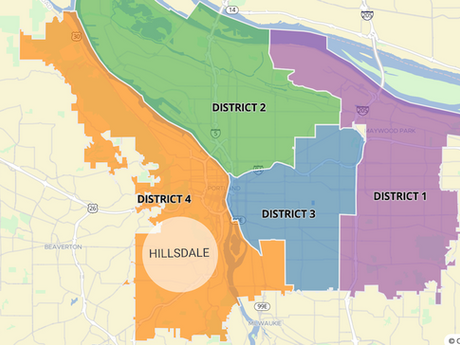top of page
Removing racial exclusions from property deeds
A How-To Guide with forms and instructions
How to remove racial exclusions from your deed
Many thanks to Alan Brickley, Amy Houchen, Layla Kailani McLean, Ode Minton-Smith and Jennifer Rollins for their help and guidance in drafting this overview of the process. This attempt to describe the necessary steps is not legal advice, your experience may differ.
Step 1: Locate your deed to see if it contains racial restrictions.
If you don’t have a copy in your files, you can look up your property at the Multnomah County division of Assessment, Recording and Taxation (DART) (Multnomah County division of Assessment, Recording and Taxation (DART). It may be necessary to visit the DART office in person. See the website for details. Copy fees may apply. A real estate agent may also be able to get this information for you at no cost.
Step 2. Download and complete forms.
There are four forms in the Discriminatory Property Provisions packet provided by the Oregon Judicial Department. Two additional forms that you may find helpful are provided here. (LINK)
Following is a list of the forms, how to fill them out, and what to do with them.
1. Petition to Remove Discriminatory Provisions (two pages). File this form with the circuit court for the county where the property is located. There are no filing fees for the Petition. The Petition can be filed in person (when the courts are open to the public again), by mail or online. The court clerk will provide you with a case number when the Petition is filed or over the phone if filing by mail. Find more information on how to file a case here.
2. General Judgment to Remove Discriminatory Restrictions to Real Property Records. Complete this form and send a copy to any other owners listed on the property title (see #3 below for more information on this). Hold on to the original, you will submit it later to the Court. To complete this form, fill in the exact language to be removed in the same way as written in the Petition (including page number, section, and paragraph, as applicable) on Line 15 where it says The discriminatory provisions to be removed from the title of the real property is/are as follows. On Line 20, write in the information requested or attach a copy. The Judge will check the appropriate box following the line: NOW THEREFORE, it is hereby ORDERED AND ADJUDGED that: The General Judgment form must meet the requirements in ORS 205.232:
-
Text must be typed, written, or printed in 8-point type or larger
-
Page size must be between 8 1/2" x 11" and 8 1/2" x 14"
-
Paper must be of a quality that can be photocopied or otherwise reproduced
-
There must be enough space for the recording sticker (4" x 2") to be placed on the first page of the document (preferably in the upper right hand corner)
3. Notice of Petition to Remove Discriminatory Provisions (one page). If there are other owners listed on the property title (including creditors such as banks, mortgagees, or other lienholders) you must notify those individuals or entities that you have filed the Petition. Review your mortgage or related loan documents to locate mailing addresses of creditors. After filing the Petition and receiving a case number, send the Notice form to each owner or creditor as described above. Send the Notice, a copy of the Petition that you filed with the court, the completed General Judgment form, and the Request for Hearing form (you do not have to fill out the Request for Hearing form) to the owners and persons or entities entitled to Notice, by registered or certified mail. Write the case number on each document or form that you are mailing. The other owners or creditors have 20 days to object and file the Request for Hearing form with the Court. If there is no request for a hearing filed by any party entitled to Notice within 20 days (plus three days for mailing) of you sending the Notice, Petition, General Judgment form, and Request for Hearing form, the Court may enter the Judgment into the Court records without a hearing.
4. Request for Hearing re: Discriminatory Provisions (one page): If there are other owners or creditors listed on the title, you must include this form when you send them the Notice of Petition to Remove Discriminatory Provisions and a copy of the Petition. You do not have to fill out this form.
5. Affidavit of Service (one page). Once you have sent the Notice form to any other owners and creditors, complete the Affidavit of Service form and sign it before a notary. File the Affidavit of Service with the court. Notaries are often available at banks, law offices, AAA, real estate offices, parcel shipping stores such as FedEx or UPS. Notary fees are $10.
6. UTCR 5.100 Certificate of Readiness. (In the same PDF as the General Judgment Form) You will complete this form and file it with the Court once the required notifications have been made and the period for a hearing to be requested (23 days) has passed.
Step 3: If 23 days have passed from the date you sent the required forms to the other owners or creditors and no one has objected, you may file the General Judgment and UTCR 5.100 with the Court to be signed by the Judge and entered into the Court record.
Step 4: Once the Court has signed the Judgement, you may choose to record the Judgment with the County Assessor’s Office so that when the property is sold or mortgaged the title company will be able to see it as recorded in the county's property records.
1. Request an Authenticated Court-certified copy of the Judgment from the court clerk, which is simply an additional page included on top of the Judgment. It may also be referred to as an “exemplified copy” or a “3-way certificate” and is preferable to a Court-certified copy, which adds a stamp to the back of the Judgment that can hinder the recording process. Submitting an Authenticated Court-certified copy will often avoid issues that can arise with a Court-certified copy. Find information on how to request copies and fees here.
2. Download a Recording Cover Sheet, complete and attach to the Authenticated Court-certified copy of the Judgement. Submit both to the County recorder’s office with the recording fee.
Recording fees are based on the number of pages that will be recorded. In Multnomah County the recording fee is $16 for the first page, $5 for each additional page. For help calculating the fee for filing your documents, call the Multnomah County Recorder’s office. The Recorder’s office will accept personal checks or certified funds, payable to the Multnomah County Recorder.
The Recorder’s office is closed to the public during the pandemic, but documents can be recorded via mail or a dropbox at the county assessor’s office.
bottom of page


























